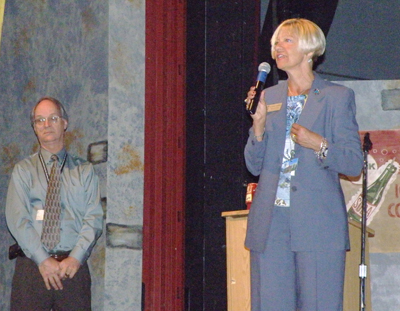Fiesta Days struggling along with bad economy
By Curtis Riggs | March 4, 2009
Worried about next year
 CAVE CREEK – A Fiesta Days official is worried about the future of next month’s annual community celebration. Sponsorships for rodeo events and reservations for the Stockman’s Club are slow coming in.
CAVE CREEK – A Fiesta Days official is worried about the future of next month’s annual community celebration. Sponsorships for rodeo events and reservations for the Stockman’s Club are slow coming in.
“I’d hate to lose the ability to put this on next year,” Desert Foothills Community Association board member Beth Cornell said. The D.F.C A. has been putting on Fiesta Days for 31 years.
The Stockman’s Club is the V.I.P. section at the Cave Creek Memorial Arena where the rodeos and the ever-popular Mutton Bustin’ are held. A Stockman’s Club membership includes two free admissions to all three-rodeo performances, a catered meal and an open bar. A Stockman’s Club membership costs $230.
Fiesta Days is scheduled for the weekend of April 3 through 5. P.R.C.A. rodeos will be held at 1 and 7 p.m. on Saturday, April 4 and at 1 p.m. on Sunday April 5.
“It’s the way to go if you want to attend all three,” Cornell said of Stockman’s Club memberships. “It is great for business networking and entertaining guests.”
Cornell said the D.F.C.A. currently has about $70,000 in the bank, which is approximately what it costs to put on Fiesta Days every year.
She points out if locals attended the rodeo events and merchants supported it with the funding level they used to it would go a long way toward helping to solve D.F.C.A. funding problems.
“If we could get the community to show up this year it would help a lot., We need to get more people in the community involved and to bring their families,” she said. She would like to see Fiesta Days become as large a community event as it used to be. “If we can’t raise what we normally raise this year, I’m worried about putting on an event next year.”
One problem facing the D.F.C.A. every year is few of its members live in Cave Creek or the surrounding area. Cornell, who lives in Desert Hills, is one of the exceptions. The lack of local involvement causes many in the community to forget about Fiesta Days until it is almost too late every year.
She said five rodeo events – bareback bronc riding, saddle bronc riding, steer wrestling and team roping – are in need of the sponsorships they normally receive. The sponsorships for each of these events had already been arranged this year.
“We thought we had sponsors, then we started getting phone calls from people telling us they couldn’t do it,” she said.
Stockman’s Club memberships are also down by about a third this year. Last year there were 60 memberships in the V.I.P. club.
To learn more about Fiesta Days visit the D.F.C.A. website, Fiestadaysrodeo.com. To help out with this year’s event call Cornell at 623-293-8445.
Photo by Curtis: Fiesta Days bull riding competition is one of the few rodeo events, which still has a sponsor for the April 3 through 5 community celebration.
CCUSD hoping for the best and preparing for worst
By Linda Bentley | March 4, 2009
‘Why does the district care if students go somewhere else?’
 CCUSD – Last Wednesday morning marked the third budget forum held by Superintendent Debbi Burdick and Associate Superintendent of Finance Kent Frison in a 12-hour period.
CCUSD – Last Wednesday morning marked the third budget forum held by Superintendent Debbi Burdick and Associate Superintendent of Finance Kent Frison in a 12-hour period.
Burdick stated, “We have an interesting way of funding education in our state – if you came from anywhere else, believe me it’s different,” as she explained how the district can only use certain funds to pay for specific things.
She urged attendees to ask their legislators to make equitable cuts by making cuts to charter schools as well and to ask the governor to fund schools with discretionary funds received from the stimulus package.
Forty percent of the state’s budget goes to education. However, some of the state’s funds are restricted by ballot measures designating certain revenue sources to be used to fund specific programs, leaving the legislature with little to work with.
Frison said, “The current year’s budget was in great shape. Each student brings additional revenue,” although the district did have to return $757,819 to the state from M&O (maintenance & operations) and unallocated soft capital.
He said the district heard about cuts in late fall and was able to make necessary reductions “without touching any people.”
The district is preparing for the worst-case scenario, which may require a $4.9 million reduction, while pricing out ongoing citizen suggestions.
The state is looking at a deficit of about a $3 billion. However, the district won’t know what the extent of its cuts will be until the legislature passes the budget.
However, if there is going to be any reduction in force (RIF), non-teaching staff must be notified of the district’s intent to rehire by March 15, while teachers must be notified by April 15.
Because the legislature didn’t pass the budget until June last year, RIF notices could be based on the worst case scenario, whereas the district could immediately rehire any employees they determine will not need to be cut.
But once the March 15 and April 15 deadlines are passed, the district is unable to make those cuts.
According to Frison, the state is proposing a $250 reduction per student in base support, equaling approximately $1.9 million.
The district has just under 6,000 students enrolled. However, Frison said they use a weighted average, which makes it the equivalent of approximately 7,600 students for which they receive a base of around $5,000 each.
Things in the mix from state cuts include $1.3 million from soft capital used to purchase textbooks and just under $1 million for group B (all-day) kindergarten.
Frison showed an additional $973,194 would be required to fund all-day kindergarten staffing plus $450,000 for health insurance.
Burdick said if the district didn’t continue to provide all-day kindergarten, “Someone else will take them,” adding, “We don’t want to turn them away.”
She said the district could go back to half-day kindergarten, “But if we hear neighboring schools are offering all-day kindergarten, we’ll lose students,” citing students tend to continue in the district where they start.
One suggestion was to eliminate five elementary physical education teachers, which Burdick said was “all of them,” explaining PE is not a statutory requirement at the elementary level.
She also said elementary teachers are able to teach PE, as well as music and art, unlike teachers in the upper grades where they must be certified in the subjects they teach.
So, it didn’t necessarily mean they would be eliminating PE at the elementary level, just specialized PE teachers.
Funding for extracurricular activities would be eliminated but, again, Burdick explained that didn’t mean the activities would go away they would just need to find alternate funding sources.
One person suggested reducing base pay across the board so no one would need to be fired, another proposed closing one elementary school and increasing class sizes, which would be a core staff savings along with utilities, while sparing teachers.
Burdick said they were aggregating all the suggestions to present to the governing board, the final decision making body.
A parent commented this was the first she’s heard about closing any schools and said, “We’re setting off emotional issues.”
Burdick stated some of the suggestions, including school closure, had only been received within the past 24 hours and statute would require the district hold a public hearing with 30 days before action is taken to close a school.
When a parent asked why parents weren’t paying to either buy or rent their students’ books, Burdick said, “We are not allowed to charge our students for education materials.”
“Why doesn’t the district eliminate electives Like IB (International Baccalaureate)?” asked another parent.
Burdick said, “There are about 200 students in the cue” and they could lose $5,000 per student in revenue if they were to go to another district. She said the way the district balances IB and AP (advanced placement) is with shared classes, as both have low enrollment.
Suggestions to change the school year to save on utilities, by going to a longer school day for less days per year, or a four-day schedule, all created a chain of new problems that Burdick said would be better dealt with on a state-wide basis.
“Why does the district care if students go somewhere else?” asked a parent, stating fewer kids would mean spending less money.
Burdick stated, “We want to keep the children of the parents in the district. If students go elsewhere it means we’re not providing parents what they want and the district receives money for growth.
“You’re right though,” said Burdick, “But if too many go it does affect class size.”
Someone asked, “What is an acceptable class size?”
Burdick replied, “Unless class size goes below 15-16 students, it doesn’t affect education.”
When asked if the district had considered the possibility of merging with other districts, Burdick explained the process.
After a parent commented about property taxes in Arizona being “the lowest I’ve seen anywhere,” another parent said she would be willing to pay $500 more in property taxes if she knew it went to the schools.
Since providing pupil transportation is also not a statutory requirement, Burdick said they would cost out what savings might be realized by eliminating the transportation department and selling its assets.
Last week Burdick called for a Financial Feasibility Committee to determine whether or not to ask district voters for money in November and, if so, what it would be for. The committee would meet until May, when it would make its recommendations to Burdick who would subsequently make her recommendations to the board.
PHOTO BY LINDA BENTLEY:
Associate Superintendent of Finance Kent Frison and Superintendent Debbi Burdick explained the budget challenges faced by the district for the upcoming year. Burdick urged attendees to write to their legislators and to the governor to request discretionary funds from the stimulus package be used to fund schools.
“A visitation from Jonathan and Janet”
March 4, 2009
Monday, March 9 in Carefree
 Combining great story telling with wit, wisdom and comedy, author Jonathan Richard Cring has been dubbed a delightful mingling of Mark Twain, the Apostle Paul and Steven Spielberg.
Combining great story telling with wit, wisdom and comedy, author Jonathan Richard Cring has been dubbed a delightful mingling of Mark Twain, the Apostle Paul and Steven Spielberg.
He is the winner of the Best Screenplay at the Top Ten Films in America for the movie, Bernee, and writes a daily blog at www.jonathots.com with national readership in the tens of thousands.
Spending his weekdays working from the film industry in writing and musical composition, on Fridays, Mr. Cring climbs in a car or hops a jet and heads off with his business partner, Janet Clazzy, the conductor of the Sumner Pops Orchestra and movie scorer, to tour the country, sharing a creative explosion at – churches.
That’s right. Churches.
“Maybe having ancient memories of my mother forcing me to go to Sunday school, I somehow feel like a bird in the wintertime, needing to return to warmer places for my fellowship and interaction,” says Cring from his headquarters and home in Hendersonville, Tennessee. “Creative people often leave the spiritual side behind when they achieve success and abandon the church to critics instead of encouraging folks who envision life in a better way.”
The pair perform five shows a weekend of music, monologue and singing to audiences who often show up not knowing quite what to expect and always leave refreshed, as one lady put it, “feeling and looking ten years younger.”
“Energy is spiritual, and when you dare to make spiritual things practical and practical things spiritual, you settle into a state that is enough to tickle every part of you. I learned a long time ago, if people agree with you they call it blessing and if they don’t, they say you are controversial. So I guess I’d call what I do “‘blessiversial’ – just enough of each to keep us both awake,” Mr. Cring concludes.
Appearing under the banner of Spirited, Jonathan and Janet will be at Christ the Lord Lutheran Church in Carefree on Monday, March 9 at 7 p.m. For more information call 480-488-2081.
